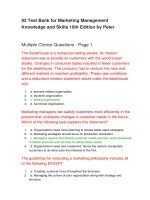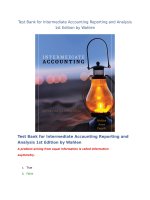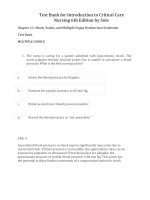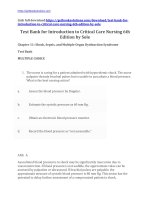Test bank for organizational theory design and change 6th edition by jones
Bạn đang xem bản rút gọn của tài liệu. Xem và tải ngay bản đầy đủ của tài liệu tại đây (84.24 KB, 18 trang )
Full file at />Organizational Behavior, Design, and Change, 6e (Jones)
Chapter 1 Organizations and Organizational Effectiveness
1) Studying organizations is relatively easy because they are tangible. That is, we can see and
touch them.
Answer: FALSE
Diff: 1
Page Ref: 1
LO: 1-1
2) One of the difficulties in studying organizations is that they are intangible. In other words, we
cannot touch or see them.
Answer: TRUE
Diff: 1
Page Ref: 1
LO: 1-1
3) Entrepreneurship is the process by which people recognize opportunities to structure
organizations more efficiently.
Answer: FALSE
Diff: 1
Page Ref: 2
LO: 1-1
4) Amazon.com was created to satisfy the need to buy books over the Internet.
Answer: TRUE
Diff: 1
Page Ref: 3
LO: 1-2
5) The degree of specialization in small companies tends to be lower than that of large
companies.
Answer: TRUE
Diff: 2
Page Ref: 4
LO: 1-3
6) Transaction costs are the costs associated with negotiating, monitoring, and governing
exchanges between people.
Answer: TRUE
Diff: 1
Page Ref: 6
LO: 1-2
7) The environment in which an organization operates is a major source of uncertainty.
Answer: TRUE
Diff: 1
Page Ref: 6
LO: 1-5
buy this full document at
Full file at />8) One reason that organizations exist is so that they can exert power and control.
Answer: TRUE
Diff: 1
Page Ref: 6
LO: 1-1
9) One reason for starting an organization is to create jobs for individuals.
Answer: FALSE
Diff: 3
Page Ref: 6
LO: 1-1
10) Economies of scope are cost savings achieved when an organization manufactures products
in large volumes.
Answer: FALSE
Diff: 1
Page Ref: 6
LO: 1-1
11) Economies of scale are cost savings achieved when an organization manufactures products in
large volumes.
Answer: TRUE
Diff: 1
Page Ref: 6
LO: 1-1
12) Transaction costs are the costs associated with negotiating, monitoring, and governing
exchanges between people.
Answer: TRUE
Diff: 1
Page Ref: 6
LO: 1-1
13) Organizational structure is used to control and coordinate people's actions.
Answer: FALSE
Diff: 2
Page Ref: 7
LO: 1-2
14) Organizational theory is primarily concerned with how an organization can outperform its
competitors.
Answer: FALSE
Diff: 2
Page Ref: 7
LO: 1-2
15) Organizations that operate in the same environment will always have similar organizational
cultures.
Answer: FALSE
Diff: 2
Page Ref: 8
LO: 1-2
buy this full document at
Full file at />16) Organizational structure can be shaped by organizational culture.
Answer: TRUE
Diff: 2
Page Ref: 8
LO: 1-2
17) The external resource approach evaluates an organization's ability to obtain scarce resources.
Answer: TRUE
Diff: 2
Page Ref: 15
LO: 1-4
18) The internal systems approach considers corporate culture.
Answer: TRUE
Diff: 2
Page Ref: 16
LO: 1-3
19) The internal systems approach evaluates an organization's ability to obtain resources.
Answer: FALSE
Diff: 2
Page Ref: 16
LO: 1-3
20) The guiding principles that the organization formally states in its annual report is called the
mission statement.
Answer: FALSE
Diff: 2
Page Ref: 18
LO: 1-3
21) Operative goals give employees direction.
Answer: TRUE
Diff: 2
Page Ref: 19
LO: 1-3
22) An organization's mission as stated in public documents is an official goal.
Answer: TRUE
Diff: 2
Page Ref: 18
LO: 1-3
23) Operative goals can be either short or long term in nature.
Answer: TRUE
Diff: 2
Page Ref: 19
LO: 1-3
24) One of the main problems with Xerox's structure was that the decentralized structure was not
very effective for creating new and innovative products
Answer: TRUE
Diff: 2
Page Ref: 26
LO: 1-3
buy this full document at
Full file at />25) In the Xerox case, Mulcahy's structural changes were the primary reason for the successful
turnaround
Answer: TRUE
Diff: 2
Page Ref: 26
LO: 1-3
26) ________ is a tool used by people to coordinate their actions to obtain something they desire
or value.
A) Entrepreneurship
B) An organization
C) A hierarchy
D) Shareholder wealth
Answer: B
Diff: 1
Page Ref: 2
LO: 1-1
27) ________ is recognizing the opportunity to satisfy a need and collecting resources to meet
that need.
A) Organizational theory
B) Organizational behavior
C) Entrepreneurship
D) Strategic management
Answer: C
Diff: 2
Page Ref: 2
LO: 1-1
28) Jeffrey Bezos saw the opportunity to sell books over the Internet, which was growing. This is
an example of ________.
A) organizational theory
B) managerial expertise
C) education
D) entrepreneurship
Answer: D
Diff: 1
Page Ref: 2
LO: 1-1
29) Which of the following is not a stage in the value creation process?
A) Input
B) Conversion
C) Output
D) Market
Answer: D
Diff: 2
Page Ref: 3
LO: 1-1
buy this full document at
Full file at />30) An organization's inputs include all except ________.
A) finished goods
B) raw materials
C) money and capital
D) information and knowledge
Answer: A
Diff: 1
Page Ref: 3
LO: 1-1
31) In the conversion process, an organization creates value by applying all except ________.
A) machinery
B) raw materials
C) computers
D) human skills
Answer: B
Diff: 1
Page Ref: 3
LO: 1-1
32) An organization's output include all except ________.
A) finished goods
B) services
C) suppliers
D) value for stakeholders
Answer: C
Diff: 1
Page Ref: 3
LO: 1-1
33) An organization:
A) facilitates the division of labor.
B) increases transaction costs.
C) has little power over individuals.
D) is a tangible entity.
Answer: A
Diff: 2
Page Ref: 4
LO: 1-1
34) Which of the following is not a reason for creating an organization?
A) To achieve economies of scale
B) To manage the external environment
C) To provide people with jobs
D) To exert power and control to achieve goals
Answer: C
Diff: 2
Page Ref: 6
LO: 1-1
buy this full document at
Full file at />35) The organization's environment includes all except ________.
A) distributors
B) competitors
C) suppliers
D) raw materials
Answer: D
Diff: 1
Page Ref: 6
LO: 1-5
36) When an organization shares resources across several products and tasks, it is able to:
A) minimize transaction costs.
B) maximize transaction costs.
C) achieve economies of scale.
D) achieve economies of scope.
Answer: D
Diff: 2
Page Ref: 6
LO: 1-1
37) Because a toy maker sells a large amount of toys, it is able to acquire plastic products to
make the toys at a cheaper price than the competition. The toy maker is taking advantage of:
A) economies of scale.
B) economies of scope.
C) organizational culture.
D) organizational design.
Answer: A
Diff: 2
Page Ref: 6
LO: 1-1
38) ________ are cost savings that result when goods and services are produced in large volume
on automated production lines.
A) Economies of scope
B) Economies of scale
C) Inputs
D) Output
Answer: B
Diff: 1
Page Ref: 6
LO: 1-1
buy this full document at
Full file at />39) A large restaurant chain decides that they are going to start serving breakfast in order to
better utilize the expense equipment that they purchased to cook with. They are taking advantage
of:
A) economies of scope.
B) economies of scale.
C) transaction costs.
D) outputs.
Answer: A
Diff: 2
Page Ref: 6
LO: 1-1
40) ________ are the costs associated with negotiating, monitoring, and governing exchanges
between people.
A) Economies of scale
B) Economies of cost
C) Transaction costs
D) Salaries
Answer: C
Diff: 1
Page Ref: 6
LO: 1-1
41) When local store managers attempt to spot trends and changes so they can respond to
customer needs, they are:
A) using large-scale technology.
B) exerting power and control.
C) managing the external environment.
D) increasing division of labor.
Answer: C
Diff: 2
Page Ref: 6
LO: 1-5
42) ________ is the study of how organizations function and how they affect and are affected by
the environment in which they operate.
A) Organizational behavior
B) Organizational theory
C) Organizational culture
D) Organizational structure
Answer: B
Diff: 2
Page Ref: 7
LO: 1-2
buy this full document at
Full file at />43) The process of selecting organizational structure and organizational culture is ________.
A) organizational design
B) organizational behavior
C) organizational domain
D) organizational environment
Answer: A
Diff: 2
Page Ref: 9
LO: 1-2
44) ________ is the formal system of task and authority relationships.
A) Organizational theory
B) Organizational behavior
C) Organizational structure
D) Organizational culture
Answer: C
Diff: 2
Page Ref: 7
LO: 1-2
45) At Microsoft, to control scientists and make use of their talents, Bill Gates put them in teams.
This was a change in ________.
A) culture
B) strategy
C) theory
D) structure
Answer: D
Diff: 2
Page Ref: 8
LO: 1-2
46) Organizational culture:
A) remains the same once it is developed.
B) controls behavior within an organization.
C) is shaped primarily by an organization's environment.
D) is the formal system of task and authority relationships.
Answer: B
Diff: 3
Page Ref: 8
LO: 1-2
47) Finding new and improved ways of using resources and capabilities to increase value is
called:
A) organizational design.
B) environmental analysis.
C) organizational change.
D) environmental scanning.
Answer: C
Diff: 3
Page Ref: 9
LO: 1-3
buy this full document at
Full file at />48) The process by which organizations move from their present state to some desired future
state is called ________.
A) restructuring
B) scanning the environment
C) organizational change
D) transaction analysis
Answer: C
Diff: 2
Page Ref: 9
LO: 1-3
49) Coca-Cola takes pride in a long-term commitment to employees; Pepsi is very political and
competitive. These are differences in ________.
A) culture
B) structure
C) theory
D) design
Answer: A
Diff: 2
Page Ref: 9
LO: 1-2
50) The means an organization uses to achieve its goals are:
A) organizational structure and organizational design.
B) organizational culture and organizational design.
C) organizational structure and organizational culture.
D) organizational theory and organizational culture.
Answer: C
Diff: 3
Page Ref: 9
LO: 1-2
51) Which of the following is not an advantage of organizational design?
A) It can help a company manage diversity.
B) It can increase organizational efficiency.
C) It can help an organization control its environment.
D) It is a good approach for evaluating organizational effectiveness.
Answer: D
Diff: 3
Page Ref: 9
LO: 1-2
52) Organizational design is:
A) a way to measure organizational effectiveness.
B) a way to measure organizational efficiency.
C) a source of competitive advantage.
D) important only to large companies.
Answer: C
Diff: 2
Page Ref: 9
LO: 1-3
buy this full document at
Full file at />53) Organizational design:
A) consists of two componentsstrategic management and organizational behavior.
B) can help a company control its environment.
C) reduces innovation.
D) does not allow for contingencies.
Answer: B
Diff: 2
Page Ref: 9
LO: 2-3
54) ________ is a means of implementing strategy.
A) Organizational theory
B) Entrepreneurship
C) Organizational design
D) Organizational missions
Answer: C
Diff: 2
Page Ref: 9
LO: 1-3
55) Which of the following are contingencies that cause the organization to face uncertainty?
A) Organizational design and organizational processes
B) The technological environment and organizational design
C) The technological environment and organizational processes
D) The organizational environment and organizational design
Answer: C
Diff: 2
Page Ref: 11
LO: 1-5
56) ________ is the ability of one company to outperform another because its managers are able
to create more value from the resources at their disposal.
A) Strategy
B) Competitive advantage
C) Organizational design
D) Managerial expertise
Answer: B
Diff: 2
Page Ref: 12
LO: 1-5
57) The specific pattern of decisions and actions that managers take in order to use core
competences to achieve a competitive advantage is called ________.
A) strategy
B) change management
C) organizational design
D) the organization's mission
Answer: A
Diff: 2
Page Ref: 12
LO: 1-3
buy this full document at
Full file at />58) Differences in race, gender, and national origin of organizational members pertain to
________.
A) organizational design
B) efficiency and innovation
C) diversity
D) competitive advantage
Answer: C
Diff: 1
Page Ref: 12
LO: 1-3
59) When organizational design is poor, ________.
A) an organization will decline
B) managers usually increase R&D expenses
C) bureaucratic costs are lower
D) managers usually increase the number of products offered
Answer: A
Diff: 2
Page Ref: 13
LO: 1-3
60) Which of the following approaches is concerned with measuring productivity?
A) External resource
B) Internal system
C) Technical
D) Transaction cost
Answer: C
Diff: 2
Page Ref: 17
LO: 1-4
61) The ________ is a method that allows managers to evaluate how effectively an organization
manages and controls its external environment.
A) external research approach
B) internal research approach
C) technical approach
D) transaction approach
Answer: A
Diff: 2
Page Ref: 16
LO: 1-4
62) The ________ is a method that allows managers to evaluate how effectively an organization
functions and operates.
A) external research approach
B) internal research approach
C) technical approach
D) economic approach
Answer: B
Diff: 2
Page Ref: 16
LO: 1-4
buy this full document at
Full file at />63) If a company uses the external resource approach, which of the following goals will it
consider most important?
A) Increasing the rate of product innovation
B) Raising stock price
C) Reducing conflict
D) Reducing production costs
Answer: B
Diff: 3
Page Ref: 16
LO: 1-4
64) Which of the following approaches is most concerned with the conversion stage of the value
creation process?
A) External resource
B) Internal system
C) Strategic group
D) Technical
Answer: D
Diff: 2
Page Ref: 17
LO: 1-4
65) In the late 1990s, what did the toy maker Mattel do in response to what it perceived were
changing consumer needs?
A) Tried to become a major player in the computer game market
B) Re-focused its efforts on classic toys, such as Barbie
C) Tried to acquire more of the game market through lower prices
D) Entered the retail arena
Answer: A
Diff: 3
Page Ref: 17
LO: 1-5
66) A computer manufacturer was concerned about its effectiveness, so it eliminated a level in its
hierarchy and decentralized decision-making authority. Which of the following approaches is it
using to evaluate organizational effectiveness?
A) External resource
B) Internal system
C) Technical
D) Transaction cost
Answer: B
Diff: 2
Page Ref: 16
LO: 1-4
buy this full document at
Full file at />67) Which of the following approaches considers organizational culture?
A) External resource
B) Internal system
C) Technical
D) Transaction cost
Answer: B
Diff: 2
Page Ref: 17
LO: 1-4
68) ________ means developing modern production facilities using new information
technologies that can produce and distribute products in a timely and cost-effective manner.
A) Efficiency
B) Control
C) Innovation
D) Organizational design
Answer: A
Diff: 2
Page Ref: 15
LO: 1-2
69) ________ means developing an organization's skills and capacities so that the organization
can discover and take advantage of new products and processes.
A) Efficiency
B) Innovation
C) Control
D) Organizational theory
Answer: B
Diff: 1
Page Ref: 15
LO: 1-2
70) ________ means having control over the external environment and having the ability to
attract resources and customers.
A) Effectiveness
B) Managerial expertise
C) Control
D) Organizational strategy
Answer: A
Diff: 2
Page Ref: 17
LO: 1-4
71) The Ford Motor case best illlustrates ________.
A) how different cultures can both succeed
B) how not managing change can negatively impact the organization
C) how a structure that is tall and inefficient can cause an organization to decline.
D) how important it is to restructure in the global economy
Answer: C
Diff: 3
Page Ref: 14
LO: 1-3
buy this full document at
Full file at />72) The case, "Mattel's Rocky Road" best illlustrates ________.
A) how mergers and acquisitions are not always the best strategy
B) how operative goals can change over time
C) economies of Scale in production.
D) the technical approach to measurement
Answer: A
Diff: 3
Page Ref: 17
LO: 1-5
73) ________ goals provide legitimacy to the organization.
A) Operative
B) Profit
C) Long-term
D) Official
Answer: D
Diff: 2
Page Ref: 19
LO: 1-3
74) The Southwest Airlines case illustrates ________.
A) how a structure that results in lower costs can be a competitive advantage
B) how Herb Keheller created a "fun place to work"
C) the contingency approach to organizational design
D) How economies of scope can make an airline profitable
Answer: A
Diff: 3
Page Ref: 18
LO: 1-4
75) ________ goals provide employee direction.
A) Operative
B) Profit
C) Long-term
D) Official
Answer: A
Diff: 2
Page Ref: 19
LO: 1-3
76) Operative goals:
A) provide legitimacy to the organization.
B) focus only on the long term.
C) focus only on the short term.
D) can be used to measure how well an organization is managing its environment.
Answer: D
Diff: 3
Page Ref: 19
LO: 1-3
buy this full document at
Full file at />77) Reducing time to market is:
A) an official goal.
B) an operative goal.
C) a goal using the external resource approach.
D) a goal using the technical approach.
Answer: B
Diff: 3
Page Ref: 19
LO: 1-3
78) List four examples of "organizational inputs."
Answer: Raw materials
Money and capital
Human resources
Information and knowledge
Customers
Diff: 2
Page Ref: 4
LO: 1-1
79) List two examples of what an organization uses to transform inputs and add value.
Answer: Machinery
Computers
Human skills and abilities
Diff: 2
Page Ref: 4
LO: 1-1
80) List four examples of "organizational outputs."
Answer: Finished Goods
Services
Dividends
Salaries
Value for stakeholders
Diff: 3
Page Ref: 4
LO: 1-1
81) List four examples of factors or entities impacting the organization's environment.
Answer: customers
shareholders
suppliers
distributors
Government
Competitors
Diff: 2
Page Ref: 4
LO: 1-1
buy this full document at
Full file at />82) A large company was successful, but has been losing market share and laying off workers.
Product development has been slow. What could be the source of the problem, and what can be
done to resolve it?
Answer: It is likely that the organization has neglected organizational design. Its structure and
culture may have worked well in the past, but both culture and structure need to be continually
evaluated. The organization needs to reevaluate both its structure and culture. To speed up
product development time, the organization could eliminate levels in the hierarchy and
decentralize decision-making authority. In addition, the structure can be designed to create crossfunctional teams to increase innovation and flexibility. In addition to changing the structure, the
organization can foster a culture that encourages innovation and risk taking.
Diff: 2
Page Ref: 9
LO: 1-2
83) Compare and contrast how structure played a role in the success/failure of Michael Dell at
Dell Computer versus the Steven Jobs at Apple computer.
Answer: This case shows students how important the proper structure is in organizing a
company. Jobs main mistake was that he did not want a management role, yet he "stuck his
fingers" in others' departments as the company grew. His management style seemed arbitrary and
overbearing, and he often played favorites between employees and teams. In short, his structure
didn't work because he created a climate of distrust and unhealthy competition between teams.
Michael Dell, on the other hand, was able to create more of a participative management approach
in which he truly involved the employees in the decision making process. Although also very
hands-on, he recognized the importance of team camaraderie and trust. In addition, he
recognized that a growing company needed expert managers.
The key to this question is to make sure students understand that management is a separate field.
Entrepreneurs may have good ideas, but structuring companies and using resources effectively
involves an entirely separate skill-set.
Diff: 2
Page Ref: 10
LO: 1-2
buy this full document at
Full file at />84) You are a consultant to Company X. The CEO insists that effectiveness must be evaluated by
an increase in stock price to satisfy stockholders. The marketing vice president insists that the
main goal is to reduce the time to bring products to the customer. The manufacturing vice
president states that costs should be the key focus of the organization. What approach is each
manager using to evaluate organizational effectiveness, and what can this organization do to
ensure that effectiveness is properly evaluated?
Answer: Goals will often conflict, but the three major tasks of management are control,
innovation, and efficiency. Each of the three managers is evaluating effectiveness on one of these
three tasks. The CEO is using the external resource approach, which measures an organization's
ability to control the environment. The marketing manager is using an internal systems approach,
which is concerned with innovation. The manufacturing manager is using a technical approach,
which is concerned with efficiency. It is understandable why each manager uses their respective
approach; after all, those are the goals that the mangers are likely to be evaluated on. However, it
is very important for an organization to evaluate all three tasks: control, innovation, and
efficiency. All three approaches must be used. The company should concerned most about the
overall collective performance of the organization.
Diff: 2
Page Ref: 18
LO: 1-4
85) Describe the value creation process for a university
Answer: This relates to the McDonalds example in Figure 1.2, but for a service organization
such as a university. Answers will vary, but make sure students understand that the value
creation process applies to organizations that produce intangible goods also.
Diff: 2
Page Ref: 3
LO: 1-1
86) Discuss how an organization can help organizations manage their external environment.
Answer: This question is based on figure 1.3. Make sure students know why organizations
exist, and also that they understand the basic definition of the external environment
Diff: 2
Page Ref: 5
LO: 1-1
87) What is the difference between economies of scale and economies of scope?
Answer: Economies of scale are cost savings from producing large volumes, economies of scope
are cost savings because of the use of shared resources.
Diff: 1
Page Ref: 6
LO: 1-1
88) Give an example of how a fast-food restaurant can use economies of scope to achieve cost
savings.
Answer: Answers need to reflect the use of underutilized resources. Serving breakfast, or
staying open until midnight are a couple of examples. Make sure the answers are not confused
with economies of scale.
Diff: 3
Page Ref: 6
LO: 1-2
buy this full document at
Full file at />89) Give an example of how a fast-food restaurant can use economies of scale to achieve cost
savings.
Answer: Answers should reflect techniques that will result in large volume production, such as
using the same hamburger patty for various products.
Diff: 3
Page Ref: 6
LO: 1-1
90) Discuss how structure may have played a role in the problems associated with the U.S. auto
industry.
Answer: You can use Organizational Insight 1.2 as a basis for this question, along with any
contemporary news about this industry.
Diff: 3
Page Ref: 14
LO: 1-3
91) Give one example each of the external, internal, and technical approaches to measuring
organizational effectiveness.
Answer: See table 1.1 on page 15.
Diff: 3
Page Ref: 15
LO: 1-4
buy this full document at









